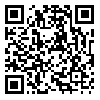BibTeX | RIS | EndNote | Medlars | ProCite | Reference Manager | RefWorks
Send citation to:
URL: http://rehabilitationj.uswr.ac.ir/article-1-484-en.html

 , Isma'il Ebrahimi
, Isma'il Ebrahimi 
 , Mohammad-Jafar Shater-Zadeh
, Mohammad-Jafar Shater-Zadeh 
 , Mahyar Salavati
, Mahyar Salavati 
 , Anooshirvan Kazem-Nezhad
, Anooshirvan Kazem-Nezhad 

Objects: The purpose of this study was to determine muscle activation patterns of shoulder girdle during some selected functional exercises of upper Limb in healthy subjects.
Materials & Methods: In this quasi-experimental study, 36 healthy women were selected by simple and convenient sampling. Surface bipolar electrodes were applied over the Pectoralis major, upper Trapezius, middle Trapezius, Infraspinatus, anterior Deltoid, middle Deltoid and posterior Deltoid. Subjects were asked to perform six functional exercises randomly. This exercises included abduction in scapular and frontal plane, D2F (Diagonal 2 Flexion), D2E (Diagonal 2 Extension), Tripod and push–up. Muscle activation pattern was studied in two temporal fields (onset and peak of muscle activation) and activity level of muscles using normalized integrated electromyography index (NIAV: Normalized the Integral of the Absolute Value). Statistical method applied in this research was analysis of variance for repeated measures (ANOVA).
Results: In the most of movement patterns evaluations, upper Trapezius was the first activated muscle in the movement with maximum level of activity in comparison with the other muscles. Pectoralis major muscle activity in both temporal and activity level fields was dependent on movement pattern. Activity of anterior and posterior Deltoid during some of the movement patterns, particularly oblique ones such as abduction in Scapular plane and D2F and D2E was also high. In all of the movement patterns, middle Deltoid acted as the prime mover and middle Trapezius and Infraspinatus showed the same level of activity.
Conclusion: Upper Trapezius is not dependent on movement pattern, but Pectoralis major is. Activity of anterior Deltoid and posterior Deltoid is dependent on movement direction. Activity of middle Deltoid is dependent to displacement of target joint in movement patterns. Middle Trapezius and Infraspinatus as stabilizer–steerers muscles are independent to movement patterns.
Received: 12/07/2010 | Accepted: 13/10/2015 | Published: 13/10/2015
| Rights and permissions | |
 |
This work is licensed under a Creative Commons Attribution-NonCommercial 4.0 International License. |



